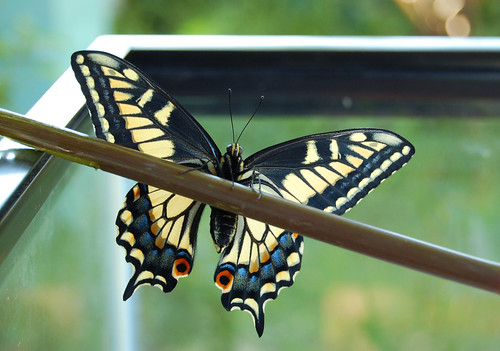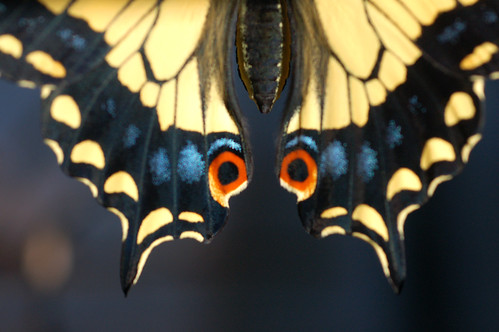A Butterfly Emerges
...

I'm not a morning person, but if Robb tells me that there's an Interesting Nature Event in progress, I'll catapult out of bed. This morning, I was rubbing my eyes, when he shouted that we had at butterfly.
We had been collecting the Anise Swallowtail caterpillars that we found on our garden fennel, and one by one they transformed into mysteriously dead-looking chrysalises. We've had quite a few people over lately, and we've all peered into the tank, and wondered when or if anything might emerge.
In truth, I had pretty much given up hoping. I might tell myself that the markings on the chrysalises were changing, but I was secretly convinced that nothing was going to happen. Reading that it takes from ten days to three months for a butterfly to emerge results in a lot of staring and worrying, two things I'm very good at doing.

Robb and I cleared a space on an outside table, and carried the butterfly tank outside. The butterfly was busily bashing into the glass, so we gave her a stalk of fennel to rest on. Her wings had already "inflated" with fluids, but she still needed to rest and gain strength.

We had a wonderful opportunity to observe her, up close. Robb noticed right way that the undersides of her wings were significantly more colorful than the top sides. When I was going through the photos, I also noticed that the patterns on the top and bottom sides did not line up. Look above the blue markings, and you'll see the sun shining through her wings. You'll notice that you can see through her wings, and see the "shadow" of her top markings.

We enjoyed looking at her licorice-whip proboscis. She kept her tongue out the whole time that she was resting. Butterflies have long hollow structures, with which they sip nectar from flowers. Apparently, butterflies don't suck up liquid (like a drinking straw) because the pressure required to pull viscous liquids through the tiny tube would be impossibly strong. Rather, they use capillary action to, much in the way that a paper towel draws in liquids.

We were enchanted by the fur on the butterfly's body, and interested to learn that these hairs, called tactile setae, connect to nerve cells, and provide the butterflies with sensory information. Caterpillars have similar structures, as well. We've probably all seen a hairy caterpillar at one time or another. Who knew that those hairs were functional sensory structures, providing the animal with information about touch, smell and sound?

Whoever gets the opportunity to look at a live butterfly this closely? And when does one get to see such fresh, undamaged wings. The scales that form the markings are like pixels, creating an image.
(Here's a link to an article on micro-photography of butterfly wings.)

The ends of the wings are slightly curved. I imagine that this offers aerodynamic advantages.

Christine was teasing me for assigning genders to the flies and bees in a previous post. But in this case, I'm confident this this butterfly is female. There are no claspers at the end of this butterfly's abdomen. A male butterfly uses his claspers to hold onto a female, during mating.

Because this is just the way the universe works, the butterfly actually flew when neither Robb nor I were present. Robb was laying down, resting his back, and I had gone inside to get another camera battery.
She was flitting around the lilac bush when I came back outside.

A few seconds of overwhelming emotion on my part, and then she flew off into the big wide world.

I'm not a morning person, but if Robb tells me that there's an Interesting Nature Event in progress, I'll catapult out of bed. This morning, I was rubbing my eyes, when he shouted that we had at butterfly.
We had been collecting the Anise Swallowtail caterpillars that we found on our garden fennel, and one by one they transformed into mysteriously dead-looking chrysalises. We've had quite a few people over lately, and we've all peered into the tank, and wondered when or if anything might emerge.
In truth, I had pretty much given up hoping. I might tell myself that the markings on the chrysalises were changing, but I was secretly convinced that nothing was going to happen. Reading that it takes from ten days to three months for a butterfly to emerge results in a lot of staring and worrying, two things I'm very good at doing.

Robb and I cleared a space on an outside table, and carried the butterfly tank outside. The butterfly was busily bashing into the glass, so we gave her a stalk of fennel to rest on. Her wings had already "inflated" with fluids, but she still needed to rest and gain strength.

We had a wonderful opportunity to observe her, up close. Robb noticed right way that the undersides of her wings were significantly more colorful than the top sides. When I was going through the photos, I also noticed that the patterns on the top and bottom sides did not line up. Look above the blue markings, and you'll see the sun shining through her wings. You'll notice that you can see through her wings, and see the "shadow" of her top markings.

We enjoyed looking at her licorice-whip proboscis. She kept her tongue out the whole time that she was resting. Butterflies have long hollow structures, with which they sip nectar from flowers. Apparently, butterflies don't suck up liquid (like a drinking straw) because the pressure required to pull viscous liquids through the tiny tube would be impossibly strong. Rather, they use capillary action to, much in the way that a paper towel draws in liquids.

We were enchanted by the fur on the butterfly's body, and interested to learn that these hairs, called tactile setae, connect to nerve cells, and provide the butterflies with sensory information. Caterpillars have similar structures, as well. We've probably all seen a hairy caterpillar at one time or another. Who knew that those hairs were functional sensory structures, providing the animal with information about touch, smell and sound?

Whoever gets the opportunity to look at a live butterfly this closely? And when does one get to see such fresh, undamaged wings. The scales that form the markings are like pixels, creating an image.
(Here's a link to an article on micro-photography of butterfly wings.)

The ends of the wings are slightly curved. I imagine that this offers aerodynamic advantages.

Christine was teasing me for assigning genders to the flies and bees in a previous post. But in this case, I'm confident this this butterfly is female. There are no claspers at the end of this butterfly's abdomen. A male butterfly uses his claspers to hold onto a female, during mating.

Because this is just the way the universe works, the butterfly actually flew when neither Robb nor I were present. Robb was laying down, resting his back, and I had gone inside to get another camera battery.
She was flitting around the lilac bush when I came back outside.

A few seconds of overwhelming emotion on my part, and then she flew off into the big wide world.

Comments
Bandaid
I loved looking at the photos. Here is a link to some Polyphemus Moth photos I think you will like: http://kimbirdz.wordpress.com/
We were lucky to have a caterpillar build its cocoon right above our front door and when it emerged it was just like these photos!! I could not invent something so strange looking, born without a mouth and living for only four days. From Leah in Centralia
I read every one of your blogs. Love keeping in touch even if I do not comment every time. But the photography in this one is so outstanding....I had to congratulate you on your photos. If you ever give up being a scenic artist....consider going to work for National Geographic!
Bandaid